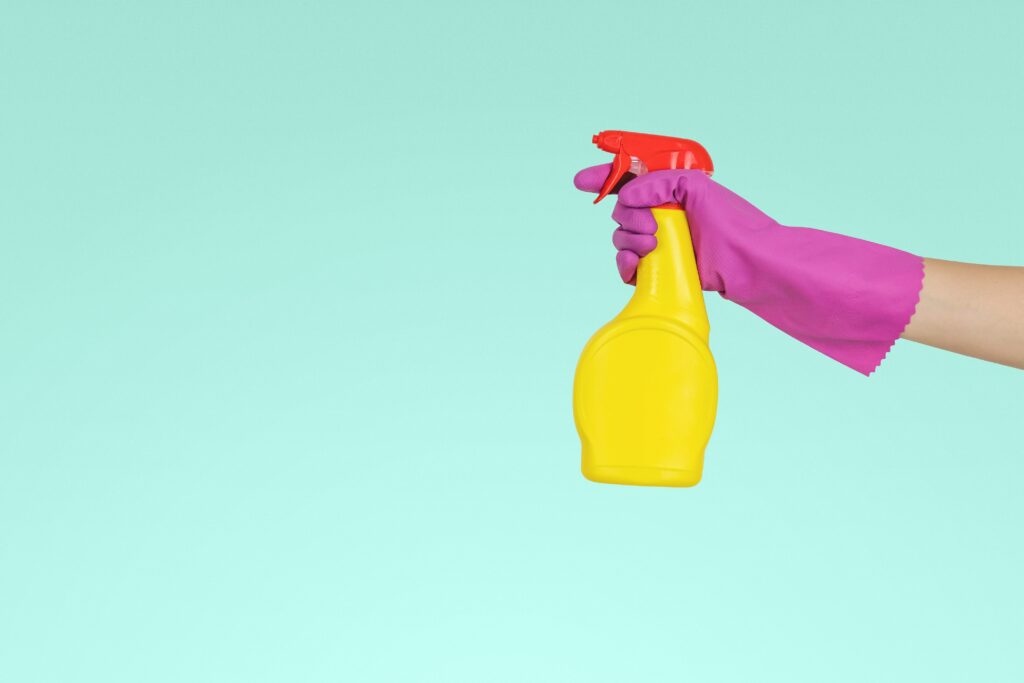Mould in the office or at home can lead to various health issues, including allergies and asthma, while also causing structural damage to your building, such as harming floorboards and insulation.
Below, we’ve put together five tips on how you can effectively clean mould and safeguard the health of your family or employees, ensuring your building remains a safe and clean place to inhabit.
1. How to Clean Mould
The first step is understanding the most effective methods for cleaning mould.
Mould can be cleaned using a variety of materials. Some robust cleaning supplies that are effective against mould include hydrogen peroxide, bleach, and ammonia. Note that bleach and ammonia should only be used on non-porous surfaces like glass and marble. Hydrogen peroxide, on the other hand, can be applied to a wider range of surfaces, including clothing.
In addition to their mould-removing capabilities, hydrogen peroxide sprays are also environmentally friendly. Other eco-friendly options include baking soda and vinegar, which are not chemically-based cleaning solutions but are still highly effective at tackling mould.
Regardless of your chosen cleaning supply, you can mix it with water to create a spray that can be used on the mould. Allow it to sit for a few hours before wiping the affected area clean. Always remember to wear protective gear when working with ammonia and bleach.
2. How to Get Mould Out of Clothes
When dealing with mould on clothing, your best options are hydrogen peroxide, baking soda, or vinegar.
If you discover mould on clothing, try to wash them as soon as possible. Allowing mould to set in can result in permanent damage to the fabric. Wash and dry the clothes promptly to prevent further mould growth. Beforehand, you can treat the clothes by soaking them in a mixture of bleach or vinegar to lift the mould stain and eliminate mildew bacteria.
If there’s excess mould on the clothing, rinse it off with hot water before applying your cleaning solution and soaking the affected item.
To prevent mould growth on clothing, ensure proper storage. Avoid overstuffing your wardrobe, as it can reduce ventilation, and position it away from the wall to minimize condensation. Mould thrives in dark, cold, and damp places. Addressing the issue at its source will better protect your clothing in the long run.
3. How to Get Rid of Mould on Walls
Mould on walls is a common issue, especially in areas with poor ventilation and insulation.
There are effective methods for eliminating mould on walls. You can mix bleach with water to create a spray or paste, which can be applied to the mould. Ensure safe usage, and check that the wall is not constructed from drywall or wood, as these porous materials won’t respond as effectively to bleach.
You can use bleach or a mixture of baking soda and vinegar to scrub the affected area before rinsing off the cleaning solution and allowing the wall to dry.
Specialised mould washes designed explicitly for mould removal can also be more thorough and effective than bleach alone. Sponge the mouldy area with a diluted mould cleaner solution, then let it dry, ensuring no residual dampness remains to discourage further mould growth.
4. Remove Mould From the Shower
Mould often thrives in showers due to the condensation caused by steam and water. It becomes a problem when walls remain damp and aren’t thoroughly dried.
You can use specialised mould cleaners and removers to clean your shower or opt for household products like bleach, baking soda, and vinegar. Create a solution with water and apply it to the affected area, then use a coarse brush to remove the mould after spraying. Your shower should be clean and mould-free.
One area prone to mould growth in the shower is the drain. Pouring a mixture of baking soda, vinegar, and water down the drain can help loosen hidden mould and eliminate bacterial odours.
To prevent mould in the shower, improve ventilation by opening windows or installing a fan or dehumidifier. Preheating the bathroom before showering can also prevent steam from reacting with cold surfaces and causing condensation.
5. What to Do With Mould
The most effective way to handle mould is to ensure your house or office is adequately insulated and well-ventilated. This reduces moisture levels, giving mould fewer opportunities to thrive.
Dehumidifiers are excellent for controlling humidity levels; ideally, they should be maintained below 50%. Ensure that air flows freely through every room, with particular attention to smaller, windowless spaces lacking natural ventilation.
To prevent mould, ensure rooms are well-lit and warm. Keep windows clean to maximize natural light and avoid overly cold and damp conditions that encourage mould growth.
Inspect drainage and guttering for any mould-promoting issues, such as leaks. We can also conduct surveys to identify and address plumbing problems that might encourage mould growth.
Removing mould is relatively straightforward when you have the right supplies and address it before it becomes a widespread issue. Whether you use ammonia, bleach, or eco-friendly materials, your home or office will be mould-free and healthier in no time.


